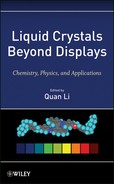Preface
Liquid crystals (LCs) were discovered more than 100 years ago, however the renaissance of research and development activities during the last quarter of 20th century led to the successful commercialization of LC devices for information displays. Currently the global market of LC displays (LCDs) stands more than $100 billion annually. Though the LCDs ubiquitous in our daily life seem mature, there is still considerable interest in the development of 3D-displays using LCs. Nevertheless parallel to this development, nowadays there is an unprecedented growth of interest for non-display applications of LCs during the 1st decade of 21st century. Consequently the research and development of LCs are moving rapidly beyond displays and evolving into entirely new scientific frontiers, opening broad avenues for versatile applications such as lasers, photovoltaics, light-emitting diodes, field effect transistors, nonlinear optics, biosensors, switchable windows, and nanophotonics. These fields, which gain extensive attentions of physicists, chemists, engineers, and biologists, are of a most engaging and challenging area of contemporary research, covering organic chemistry, materials science, bioscience, polymer science, chemical engineering, material engineering, electrical engineering, photonics, optoelectronics, nanotechnology, and renewable energy.
This book does not intend to exhaustively cover the field of LCs beyond displays, as it is extremely difficult to do so within a single book. Instead, the book focuses on the recent developments of most fascinating and rapidly evolving areas related to the theme. The chapters span the following topics: LC lasers (Chapter 1), self-organized semiconducting discotic LCs (Chapter 2), magnetic LCs (Chapter 3), ferroelectric LCs for nonlinear optical applications (Chapter 4), photo-stimulated phase transformations in LCs (Chapter 5), light-driven chiral molecular switches or motors in LC media (Chapter 6), LC functionalized nano- and microfibers produced by electrospinning (Chapter 7), functional LC block copolymers (Chapter 8), semiconducting applications of polymerizable LCs (Chapter 9), LCs of carbon nanotubes and carbon nanotubes in LCs (Chapter 10), LCs in metamaterials (Chapter 11), ferroelectric colloids in LCs (Chapter 12), cybotactic groups in the nematic phase of bent core mesogens (Chapter 13), lyotropic chromonic LCs: emerging applications (Chapter 14), LC-based chemical sensors (Chapter 15), LCs for switchable windows (Chapter 16), and LCs for nanophotonics (Chapter 17). In each chapter, the state-of-the-art along with future potentials in the respective fields has been discussed and highlighted by the leading experts.
I hope this book is not only to introduce fundamental knowledge, illustrative examples, and successful applications beyond displays, but also to stimulate more interest for further development in this realm of research, wishing the interdisciplinary actions of physicists, chemists, engineers, and biologists can bring grateful values to push the LCs research forward in the 21st century. For graduate students, researchers, and scientists from other fields who want to get involved in LCs, this book is anticipated to serve as a beginners' guide. For established researchers, this book is expected to provide insights into knowledge beyond their expertise. I sincerely hope this book can generate interest to readers and help researchers to spark creative ideas.
I would like to express my gratitude to Jonathan Rose at John Wiley & Sons, Inc. for inviting us to bring this exciting field of research to a wide audience, and to all our distinguished contributors for their dedicated efforts. Also I am indebted to my wife Changshu, my sons Daniel and Songqiao for their great support and encouragement.
Quan Li
Kent, Ohio
August 2011
